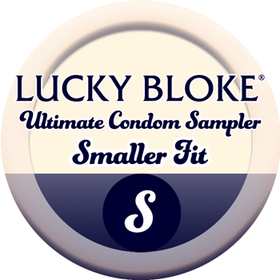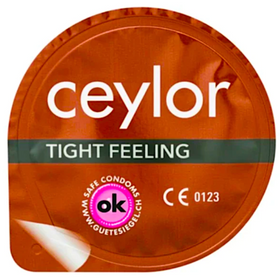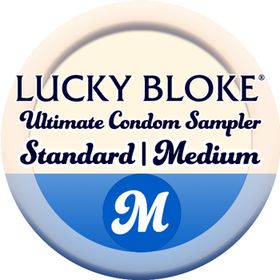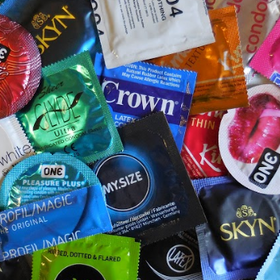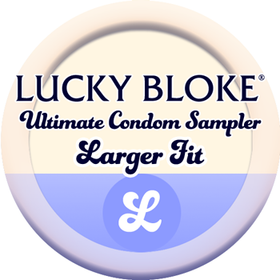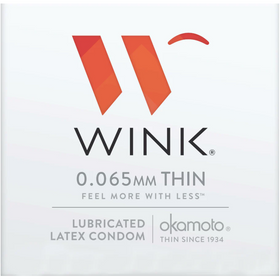A Guide To Non Latex Condoms, Latex Sensitivities & Condom Choices
The questions around non latex condoms and latex free condoms abound on the Internet. Which latex free condom is best? Do non-latex condoms expire? What happens if you keep condoms in your wallet? At what rates do condoms actually prevent STIs and STDs? Do they prevent pregnancy at the same rates?
Here we’re giving you everything you need to know about non latex and latex free condoms so you can stop worrying about the answers and get back to your satisfying sex life. And, yes, we do carry this best kinds of condom in many sizes (most importantly) and with many add-ons and enhancements (flavored, studded etc.), so that you do not have to scour the Internet and end up with mediocre condoms. In fact we continually curate all the best condom options and have the customer rated top choices to share with you.
So let’s begin.
What is the difference between a latex and a non latex condom?
The material. Latex condoms are typically made from either naturally occurring rubber latex harvested from trees much like we get sap for syrup, or from synthetic rubber that is manufactured in a factory. Regardless of how it’s created, the material is the same stuff you find in wetsuits, tires, rubber bands, latex gloves and much, much more. Rubber is widely used across the globe because of its immense elastic properties and how inexpensive it is to curate or produce.
Non latex is just as it implies, it’s a synthetic rubber that’s made out of polyurethane, lambskin, or polyisoprene. The principal difference is that the properties that create an allergic latex reaction or senstivity aren't in these synthetic materials, making them safe for anyone with a latex sensitivity or latex allergy.
How do you know if you have a latex sensitivity or latex allergy?
Typically, people find this out based on visits to the doctor, dentist, or any interaction with a person wearing rubber gloves. You can of course get properly tested at your physician's office, but if you have noticed an irritation after coming into contact with latex gloves, that is usually the giveaway that there’s more going on. You will likely want to get a formal diagnosis from your doctor. However you manage it, the use of latex free condoms is a great alternative for everyone and something you can add to your sex life immediately.
It is important to note that these non-latex condoms are often simply superior to latex condoms. And they are a great option whether or not you (or your partner) have a latex sensitivity.
What is the best non latex condom?
Here, size matters first and personal preference comes second. Latex sensitivities are serious and they can obviously affect both partners. But, if you’re wearing the wrong size condom, you can end up with slippage, breakage, chaffing, or an unwanted STI/STD or pregnancy.
Get measured or measure you partner so you know what to buy.
Once you know the size, purchasing condoms becomes significantly easier because, as you’ll find, not all purveyors offer both your size and the condom you like. And there’s nothing worse than taking a quick trip to the 7-11 or Walgreens and having to settle for a subpar condom. Get the ones you need early so you’re ready when the moment arrives. In this equation, you will never be disappointed in being prepared.
Second in this little formula comes options.
We investigated the best condoms for latex sensitivities and wrote a detailed review. Read it before making a purchase unless you know what ones can serve you best. It may also surprise you to know that latex free condom options are not limited to big brands or traditional condoms. Female condoms are also available in latex free versions as are some of the thinnest, most boutique options on the market.
And speaking of brand names, one question we’re often asked is does Trojan make non latex condoms?
Trojans doesn’t just make one latex free condom, they make two and we carry them both. Trojan Supra and Trojan Naturalamb Luxury. Both condoms are quality options for people with latex sensitivities, but there is some controversy surrounding how well the natural lamb condom does protecting against STIs and STDs. For that reason, the natural lambskin condoms are a better fit for monogamous couples and to prevent unwanted pregnancy, not STDs.
After reviewing hundreds of condom options, the truth here is that non latex condoms are not really Trojans forte. If you want to try an assortment of non latex condom options, check these samplers out: latex free standard fit / larger-wider fit.
If you’re looking for a condom company more committed to the needs of latex sensitive clients, Lifestyles SKYN and Unique condoms are superior. Further the Unique brand has been the customer favorite fand go to condom (non latex option) for years. The Unique condom range is also available in snug, standard and large fit.)
Next let’s talk lube, because condoms need lube to be safe, have less breakage, and to offer optimal pleasure for both partners. And here, there are some considerations.
What lube can I use with non latex condoms?
With non latex condoms, it’s best to use water based or silicone based lubricant. Both work well, but there are some fundamental differences. Water based lubes are soluble in water so they're super easy to clean up. However, it does often require reapplying for the best affect.
Silicone lubes are the slickest lubes and work well in any water situation like a hot tub or the swimming pool. With this kind of lube, one application is usually enough.
We have lube samplers for both the best water based lubes and silicone based lubricants so you can try out the various brands to find what’s best for you.
And honestly, a little thought to the sexual situations goes a long way here. If you want to have sex in the shower, for example, silicone lube is for you.
Can you get pregnant with non latex condoms?
Buying the right size condom, putting the condom on properly, and using lube is the best way to prevent an unwanted pregnancy. Otherwise, of course you can if the condom breaks or slips and slides around.
In this arena, all condoms are the same.
Are polyurethane condoms as effective as latex?
Yes, all condoms have the same success rate which, according to Planned Parenthood, is 98% effective at preventing pregnancy.
Where people run into issues is with user error and buying the wrong size. If it’s too small, it will break. If it’s too big, it can slip off. And if you don't wear a condom consistently it cannot protect you and your partner.
Are latex condoms bad for you?
We are often asked if latex is bad. It’s not unless you have a sensitivity or allergy. But that doesn’t mean you can’t benefit from a nonlatex condom. Many latex free brands provide superior pleasure – they don’t have an offensive smell; they’re more like natural skin; the heat transfer is better so it actually feels like you’re skin to skin; there is an enhanced sensitivity for the person wearing it and overall; it’s less drying causing less chafing.
If those are the benefits you want from your condom, you should expand your reach and give them a try.
Now let’s talk about caring for your condoms and how long they really last…
Do condoms expire?
Yes, typically, a condom that you buy from a reputable source (not eBay or Amazon where many condoms are discounted as they're close to expiration), should have a shelf life of 2-4 years. In the expiry date department, there is really not much difference between latex or non-latex. If you happen to have older condoms, check the expiration date and you’ll see what the manufacturer recommends.
Do condoms expire in your wallet?
Keeping condoms in your wallet is not a good idea because the movement of your wallet and the things in it make your condoms more fragile and likely to break. But, it doesn’t change the expiration date.
Now if you put a condom in your wallet for one night, that isn’t going to create this issue, that’s just practical. But keeping them in there long term isn’t wise.
If this is your best way to carry them, the already awesome Unique condom has a 3 pack condom pack (the size of a credit card) designed to be carried in your wallet. So you can be prepared and have your condoms packaged in a way that’s less vulnerable.
Where is the best place to keep your condoms?
The best place to store your condoms might be your bedside table or nightstand. Really anywhere they won’t come into contact w/sharp objects, frequently changing temperatures, and are easy to access when needed.
When it comes to latex allergies and sensitivities you want to make sure you’re prepared. Having the right condom on hand can literally make the difference between having safe sex and missing out altogether.
Now that you know all about the needs, options, and value to non-latex condoms, it’s time to find which one is right for you.
We've curated the best assortment of non latex condoms into a sample pack so you can try them all and see what feels, smells, and works best for your body and your partner.
And don’t forget the lube. Sexual pleasure is enhanced every time when it’s done right and condoms demand a little lube.
Have a question about anything related to condoms, sexual safety, or sexual health? Let us know so we can connect you with the best condoms and sexual aid products to enhance your sexual pleasure right away.

